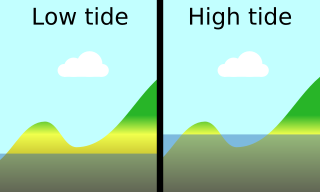
Spurn is a narrow sand tidal island located off the tip of the coast of the East Riding of Yorkshire, England that reaches into the North Sea and forms the north bank of the mouth of the Humber Estuary. Prior to a severe storm in February 2017, which damaged part of the sandbank, Spurn was a spit with a semi-permanent connection to the mainland. A storm in 2013 made the road down to the end of Spurn impassable to vehicles at high tide.

Coquet Island is a small island of about 6 hectares, situated 1.2 kilometres (0.75 mi) off Amble on the Northumberland coast, northeast England.
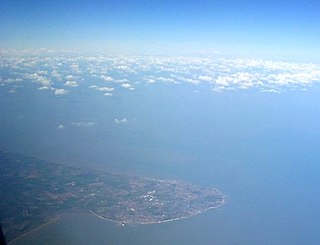
North Foreland is a chalk headland on the Kent coast of southeast England.
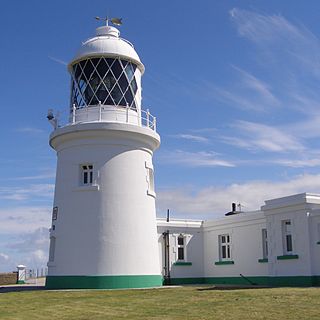
Pendeen Lighthouse, also known as Pendeen Watch is located 2 kilometres (1.2 mi) to the north of Pendeen in west Cornwall, England, United Kingdom. It is located within the Aire Point to Carrick Du SSSI, the Cornwall Area of Outstanding Natural Beauty and the Penwith Heritage Coast. The South West Coast Path passes to the south.

St. Mary's Island is a small sandstone island near the seaside resort of Whitley Bay, Tyne and Wear, England. It is a Local Nature Reserve.
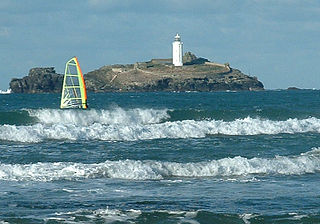
Godrevy Lighthouse was built in 1858–1859 on Godrevy Island in St Ives Bay, Cornwall. Standing approximately 300 metres (980 ft) off Godrevy Head, it marks the Stones reef, which has been a hazard to shipping for centuries.

South Foreland Lighthouse is a Victorian lighthouse on the South Foreland in St. Margaret's Bay, Dover, Kent, England, used to warn ships approaching the nearby Goodwin Sands. Built in 1843, it went out of service in 1988 and is currently owned by the National Trust. It is notable as having been the first lighthouse to use an electric light, and was the site chosen by Guglielmo Marconi for his pioneering experiments in wireless radio transmissions.

Happisburgh Lighthouse in Happisburgh on the North Norfolk coast is the only independently operated lighthouse in Great Britain. It is also the oldest working lighthouse in East Anglia.

Start Point lighthouse was built in 1836 to protect shipping off Start Point in south Devon, England. Open to the public in summer months, it is owned and operated by Trinity House. It has been designated by English Heritage as a grade II listed building.

Portland Bill Lighthouse is a functioning lighthouse at Portland Bill, on the Isle of Portland, Dorset, England. The lighthouse and its boundary walls are Grade II Listed.

Bull Point Lighthouse is a lighthouse on Bull Point, about one mile (1.6 km) north of the village of Mortehoe, on the northern coast of Devon, England. The lighthouse provides a visual aid to the villages of Mortehoe, Woolacombe and Ilfracombe, and warns of the inhospitable and rocky coast that lines the area.

Wolf Rock Lighthouse is on the Wolf Rock, a single rock located 18 nautical miles east of St Mary's, Isles of Scilly and 8 nautical miles southwest of Land's End, in Cornwall, England. The fissures in the rock produce a howling sound in gales, hence the name.

Hartland Point Lighthouse is a Grade II listed building at Hartland Point, Devon, England. The point marks the western limit of the Bristol Channel with the Atlantic Ocean continuing to the west. Trinity House, the lighthouse authority for England and Wales, have a lighthouse on the tip of the peninsula.
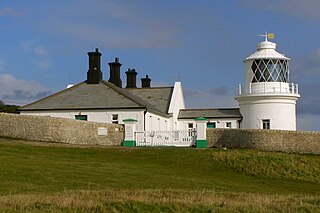
The Anvil Point Lighthouse is a lighthouse located near Swanage in Dorset, southern England.

St Catherine's Lighthouse is a lighthouse located at St Catherine's Point at the southern tip of the Isle of Wight. It is one of the oldest lighthouse locations in Great Britain.

Flamborough Head Lighthouse is an active lighthouse located at Flamborough, East Riding of Yorkshire. England. Flamborough Head Lighthouse acts as a waypoint for passing deep sea vessels and coastal traffic, and marks Flamborough Head for vessels heading towards Scarborough and Bridlington.
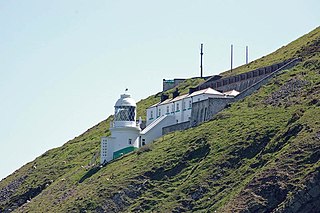
Lynmouth Foreland Lighthouse is located on Foreland Point. It was completed in 1900 to assist vessels passing through the Bristol Channel, and is a round brick tower painted white. The light is 67 metres (220 ft) above the high tide, and flashes 4 times every 15 seconds; the optic is very similar to that installed in Pendeen Lighthouse the same year.

Orfordness Lighthouse is a decommissioned lighthouse on Orford Ness, in Suffolk, England. The 30 metres (98 ft) tower was completed in 1792. The light had a range of 25 nautical miles. It was equipped with an AIS transmitter with MMSI 992351016.

The Heugh Lighthouse is a navigation light on The Headland in Hartlepool, in north-east England. The current lighthouse dates from 1927; it is owned and operated by PD Ports. It is claimed that its early-Victorian predecessor was the first lighthouse in the world reliably lit by gas.



